Top 10s: 1990s’ Japanese Sports Cars
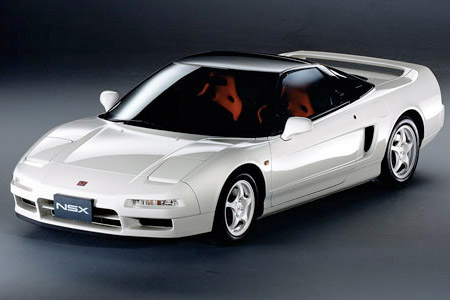 By John LeBlanc
Riding the wave of profits from their fast-selling mainstream models, a well-earned reputation for reliability and a low-valued Yen, Japanese automakers like Honda, Mazda, Toyota, Nissan and Mitsubishi spent the 1990s trying to one-up each other, making one great driving sports car after another.
Of course, after Japan’s long financial crisis during that decade, those 1990s cars are long gone but not forgotten. Now spoken in the same reverential manner nostalgic British sports car fans speak of MGs and Triumphs, here are my Top 10 Japanese 1990s Sports Cars:
By John LeBlanc
Riding the wave of profits from their fast-selling mainstream models, a well-earned reputation for reliability and a low-valued Yen, Japanese automakers like Honda, Mazda, Toyota, Nissan and Mitsubishi spent the 1990s trying to one-up each other, making one great driving sports car after another.
Of course, after Japan’s long financial crisis during that decade, those 1990s cars are long gone but not forgotten. Now spoken in the same reverential manner nostalgic British sports car fans speak of MGs and Triumphs, here are my Top 10 Japanese 1990s Sports Cars:

10. 1990 to 1999 Mitsubishi Eclipse GSX
Mitsubishi still offers its aging Eclipse 2+2 coupe today. But it’s a fatter, less driver-oriented version of the 1990s original. Also sold as an Eagle Talon and Plymouth Laser, you could buy base, front-wheel-drive versions. But I remember driving a comfortable 230 km/h in an AWD Laser RS Turbo (lent to me by a local dealer) courtesy of its 195 hp 2.0-litre 16-valve DOHC four. The second-generation Eclipse/Talon/Laser got a bump in horsepower to 210. But the writing was on the wall. The Talon was discontinued in 1998, and Eclipse eventually lost its AWD and high-strung turbo versions.
1990s original. Also sold as an Eagle Talon and Plymouth Laser, you could buy base, front-wheel-drive versions. But I remember driving a comfortable 230 km/h in an AWD Laser RS Turbo (lent to me by a local dealer) courtesy of its 195 hp 2.0-litre 16-valve DOHC four. The second-generation Eclipse/Talon/Laser got a bump in horsepower to 210. But the writing was on the wall. The Talon was discontinued in 1998, and Eclipse eventually lost its AWD and high-strung turbo versions.
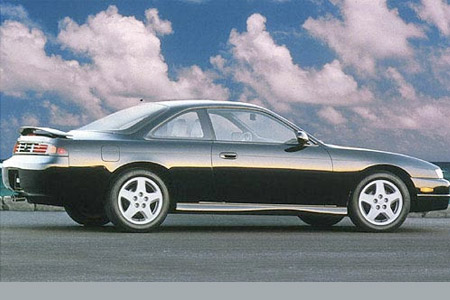
9. 1989 to 1998 Nissan 240SX
As Nissan was preparing to bump up its Zed car a notch (or ten) for the 1990 model year, product planners decided to do the same for its 200SX replacement. The result was the rear-wheel-drive 240SX 2+2 coupe, sporting a 2.4-litre four and available in three body styles. The 240SX was completely redesigned (again!) for 1995. The hatchback and convertible body styles were dropped, leaving only the coupe. It also became a bit larger, with a longer wheelbase and wider track. When the 240SX was canned, it left Nissan without a proper sports car, until the return of the 350Z in 2003.
planners decided to do the same for its 200SX replacement. The result was the rear-wheel-drive 240SX 2+2 coupe, sporting a 2.4-litre four and available in three body styles. The 240SX was completely redesigned (again!) for 1995. The hatchback and convertible body styles were dropped, leaving only the coupe. It also became a bit larger, with a longer wheelbase and wider track. When the 240SX was canned, it left Nissan without a proper sports car, until the return of the 350Z in 2003.
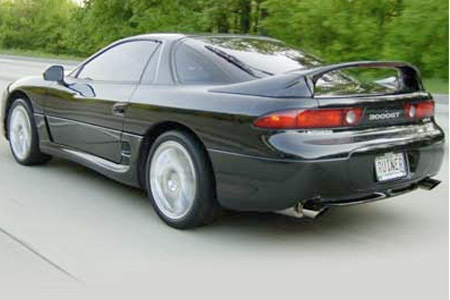
8. 1990 to 2001 Mitsubishi 3000 GT
Built to rival such 1990 Japanese sports cars as the Toyota Supra, Mazda RX-7 and Nissan 300ZX, the 3000 GT (sold as the Mitsubishi GTO in its home market) was the Japanese automaker’s first (and last) large, grand touring, 2+2 car. Also sold as a rebadged Dodge Stealth between 1991 and 1996, the 3000 GT wasn’t as sharp to drive as some of its rivals. But it did showcase Mitsubishi’s engineering prowess, including full time four-wheel drive, four-wheel steering, electronically controlled suspension, active aerodynamics featuring automatically adjusting front and rear spoilers, and sport/tour exhaust modes.
the 3000 GT (sold as the Mitsubishi GTO in its home market) was the Japanese automaker’s first (and last) large, grand touring, 2+2 car. Also sold as a rebadged Dodge Stealth between 1991 and 1996, the 3000 GT wasn’t as sharp to drive as some of its rivals. But it did showcase Mitsubishi’s engineering prowess, including full time four-wheel drive, four-wheel steering, electronically controlled suspension, active aerodynamics featuring automatically adjusting front and rear spoilers, and sport/tour exhaust modes.
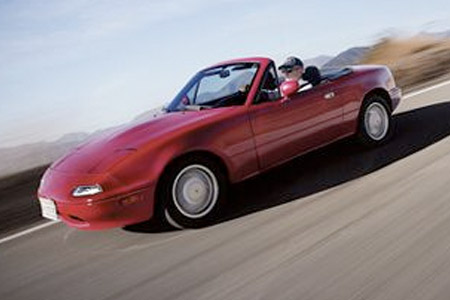
7. 1989-1997 Mazda Miata
You could argue that Mazda started its reputation as a sports car maker in North America ten years early with the first RX-7. But it was the 1989 Miata that established the Japanese automaker as a committed maker of cars for driving enthusiasts that continues on today. Noting the demise of entry-level, rear-wheel-drive, two-seat sports cars like the MGs, Triumphs, Alfa Romeos and Fiat that were killed off by the 1990s, the Miata was created by a pair of California-based Mazda product planners. The Miata definitely filled a hole. And although it has marginally grown larger and heavier over the years, (now known as the less romantic MX-5) the Mazda two-seater’s popularity has prevented it from going the way of most of the sports cars on this list.
early with the first RX-7. But it was the 1989 Miata that established the Japanese automaker as a committed maker of cars for driving enthusiasts that continues on today. Noting the demise of entry-level, rear-wheel-drive, two-seat sports cars like the MGs, Triumphs, Alfa Romeos and Fiat that were killed off by the 1990s, the Miata was created by a pair of California-based Mazda product planners. The Miata definitely filled a hole. And although it has marginally grown larger and heavier over the years, (now known as the less romantic MX-5) the Mazda two-seater’s popularity has prevented it from going the way of most of the sports cars on this list.
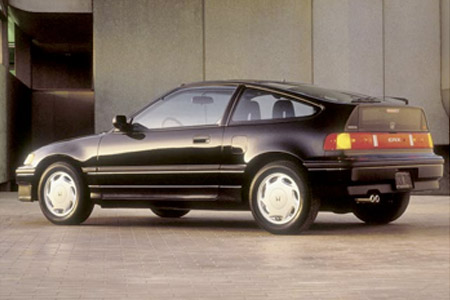
6. 1988 to 1991 Honda CR-X Si
When Honda’s marketing types tell you their new, two-seat, front-wheel-drive 2011 CR-Z hybrid sports car is a reincarnation of the CR-X, it’s images of the second-generation models they want to invoke, one of the greatest entry-level sports cars ever made. Lesser powered, fuel-sipping versions of the CR-X made great commuter cars. But the one to get (in fact, my first “new” car and one I still regret selling) was the topline Si, sporting a 108 hp 1.6-litre four. Honda followed up with a so-called “third-generation” CR-X in 1992. But the fatter, more complicated and less driver-focused targa-topped Del Sol couldn’t deliver its predecessor’s driving mojo.
car is a reincarnation of the CR-X, it’s images of the second-generation models they want to invoke, one of the greatest entry-level sports cars ever made. Lesser powered, fuel-sipping versions of the CR-X made great commuter cars. But the one to get (in fact, my first “new” car and one I still regret selling) was the topline Si, sporting a 108 hp 1.6-litre four. Honda followed up with a so-called “third-generation” CR-X in 1992. But the fatter, more complicated and less driver-focused targa-topped Del Sol couldn’t deliver its predecessor’s driving mojo.
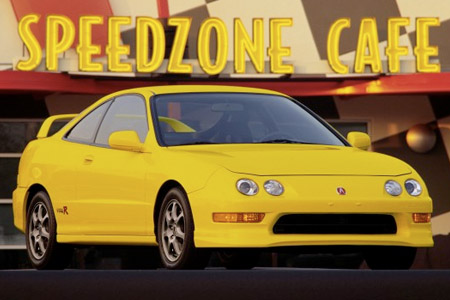
5. 1997 to 2001 Acura Integra Type-R
If you walked into an Acura showroom today, it would be easy to forget the brand was once a driving enthusiast’s wet dream in the 1990s. Honda’s premium North American brand got all the good stuff (see NS-X below), including the now legendary Integra Type-R. Built off the third-generation, front-wheel-drive, Integra hatchback, the Type-R was a factory-built tuner car. Every aspect of the hatch — engine bay, seats, chassis — was engineered to deliver maximum driving pleasure, sometimes at the expense of driver comfort (the air-conditioning system was optional in early models and nearly all the sound-dampening material was eliminated).
enthusiast’s wet dream in the 1990s. Honda’s premium North American brand got all the good stuff (see NS-X below), including the now legendary Integra Type-R. Built off the third-generation, front-wheel-drive, Integra hatchback, the Type-R was a factory-built tuner car. Every aspect of the hatch — engine bay, seats, chassis — was engineered to deliver maximum driving pleasure, sometimes at the expense of driver comfort (the air-conditioning system was optional in early models and nearly all the sound-dampening material was eliminated).
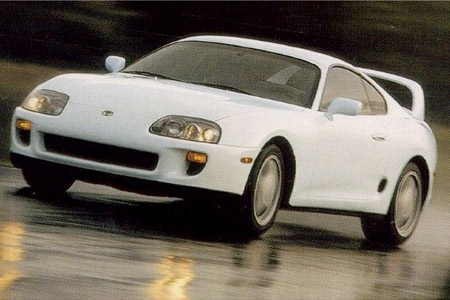
4. 1993 to 2002 Toyota Supra Turbo
The Supra started out in 1976 as a rival to the likes of American personal luxury coupes like the Buick Regal or Oldsmobile Cutlass, essentially a Celica with a stretched nose and an inline six. But by 1993, the fourth (and what might be final) generation of Toyota’s top-line sports car ended up as a world-class performance machine. With 320 hp from its twin-turbocharged six, the Supra Turbo trumped its 300ZX rival by about a half-second in 0-100 km/h runs. But like the Nissan, Japan’s currency woes made the Toyota too expensive to sell. Although production continued in its home market until 2002, sales in Canada ended in 1997.
Regal or Oldsmobile Cutlass, essentially a Celica with a stretched nose and an inline six. But by 1993, the fourth (and what might be final) generation of Toyota’s top-line sports car ended up as a world-class performance machine. With 320 hp from its twin-turbocharged six, the Supra Turbo trumped its 300ZX rival by about a half-second in 0-100 km/h runs. But like the Nissan, Japan’s currency woes made the Toyota too expensive to sell. Although production continued in its home market until 2002, sales in Canada ended in 1997.
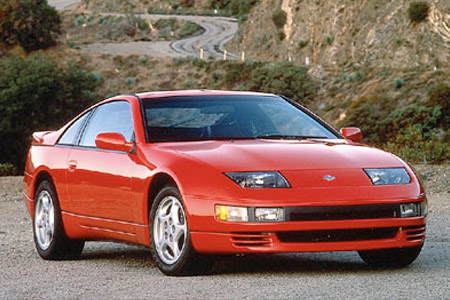
3. 1990 to 1996 Nissan 300ZX
By the time the third-generation Nissan Zed car arrived in 1984, it had become a cartoon character of the 1969 original. Bigger, fatter, and oddly styled from the folded-paper school of design, Nissan knew it had to reset the next Z due in 1990 — and boy, did it succeed. The first production car entirely designed using a computer, the 1990 Nissan 300ZX only retained the 3.0-litre V6 from its lame predecessor; everything else was new. The most heralded model was the 300ZX Turbo, with its 300 hp engine that could hurl the Nissan sports car to 100 km/h in the 5.5-second range, and top out at a governed 250 km/h. Despite the critical acclaim, by 1996 the rising Japanese Yen nearly doubled the 300ZX’s price from six years earlier. It would take until 2003 for Nissan to reintroduce the Zed car.
the 1969 original. Bigger, fatter, and oddly styled from the folded-paper school of design, Nissan knew it had to reset the next Z due in 1990 — and boy, did it succeed. The first production car entirely designed using a computer, the 1990 Nissan 300ZX only retained the 3.0-litre V6 from its lame predecessor; everything else was new. The most heralded model was the 300ZX Turbo, with its 300 hp engine that could hurl the Nissan sports car to 100 km/h in the 5.5-second range, and top out at a governed 250 km/h. Despite the critical acclaim, by 1996 the rising Japanese Yen nearly doubled the 300ZX’s price from six years earlier. It would take until 2003 for Nissan to reintroduce the Zed car.
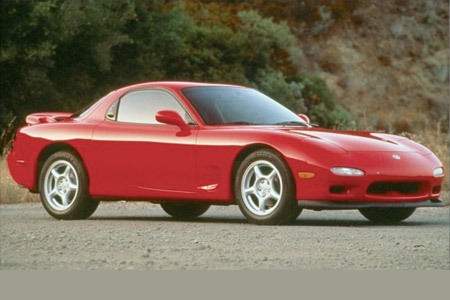
2. 1993 to 1995 Mazda RX-7
Between the Miata roadster, CR-X-like MX-3, and mid-size MX-6 coupe, Mazda was a veritable hot bed of fun-to-drive cars in the 1990s. And leading the brand was its flagship RX-7. Only sold in Canada for three model years, the third-generation RX-7 was a technical masterpiece. Its rotary engine possessed the first-ever mass-produced sequential twin-turbocharger system to come from Japan. Its lightweight aluminum bodywork and front-mid-ship engine placement resulted in a 50:50 front-rear weight distribution ratio and a low centre of gravity, making the Mazda sports car one of the finest handling and best balanced cars of all time. Unfortunately, like Nissan with its 350Z, it would take another eight years before Mazda would introduce a successor, the 2003 RX-8.
bed of fun-to-drive cars in the 1990s. And leading the brand was its flagship RX-7. Only sold in Canada for three model years, the third-generation RX-7 was a technical masterpiece. Its rotary engine possessed the first-ever mass-produced sequential twin-turbocharger system to come from Japan. Its lightweight aluminum bodywork and front-mid-ship engine placement resulted in a 50:50 front-rear weight distribution ratio and a low centre of gravity, making the Mazda sports car one of the finest handling and best balanced cars of all time. Unfortunately, like Nissan with its 350Z, it would take another eight years before Mazda would introduce a successor, the 2003 RX-8.
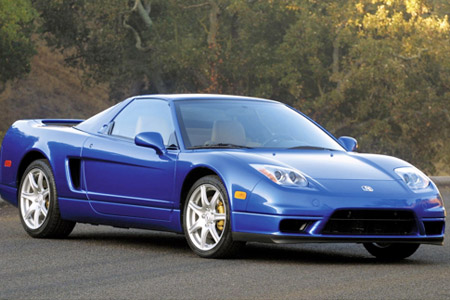
1. 1990 to 2005 Honda NS-X
Targeting what was considered the top super sports car of the time, the Ferrari 348, let’s just say Honda was setting it sights high with its NS-X, a two-seat, mid-engine, rear-wheel drive setup powered by an all-aluminum V6 gasoline engine featuring Honda's revolutionary Variable Valve Timing and Lift Electronic Control (VTEC) system. For the money, nothing could touch the Acura when it came to its remarkable handling. Marketed as the first "Everyday Supercar”, the NS-X actually forced Ferrari to make its cars more reliable and easier to maintain. Well, relatively… Unfortunately, Honda lost interest in the NS-X. In the time Ferrari rolled out 348 successors like the F355, 360 and F430, the Honda fell behind technically. Subsequently, NS-X sales dwindled to a trickle until it was canned in 2005.11.11.10 | Honda, lists, Mazda, Mitsubishi, Nissan, top 10's, Toyota | Comments Off on Top 10s: 1990s’ Japanese Sports Cars




